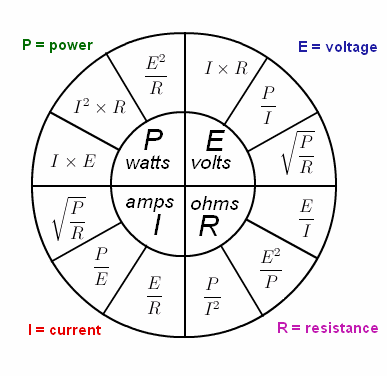Published Monday March 2, 2015:
Reducing L2 Charging Inefficiencies
Recently I started thinking about the charging losses in house wiring for the much higher powered L2 charging stations. While the wire conductors are thicker and the voltages higher, I was curious what the resistive power losses were and if they were significant.
There are now 6 dedicated 240VAC circuits feeding into the garage. One for a welder, three for L2 charging stations and two for solar inverters backfeeding the house. I originally ran 10 AWG wire to two of those circuits. Later I added 2 additional circuits but used higher gauge wiring to allow for even faster charging in the future.

Lots of charging capacity and power for toys.

Three Juicebox charging stations: Sufficient to quick charge 3 electric cars simultaneously.
Open circuit voltage was measured inside the JuiceBox L2 charging station and it was found to be 236 VAC regardless of the outlet.
Good! That’s what we should expect. (Any additional losses in the charging cable itself are not included, but given the length and gauge of that wiring, they should be pretty small).
I plugged in my wife’s Nissan Leaf (with a 6.6kW onboard charger) and then measured the voltage inside the charging station again.
According to ohms law, since we know the power draw, and the voltage drop, we can calculate the current draw (~27.5 Amps) and then calculate power loss through the wiring.
Circuit Length Volts AC Power Loss Energy Loss
Open Circuit Voltage n/a 236 0 watts 0 Wh/mi
10 AWG 30 Amp circuit 30' 233 82.5 watts 4.1 Wh/mi
8 AWG 40 Amp circuit 30' 234 55 watts 2.7 Wh/mi
6 AWG 50 Amp circuit 20' 235 27.5 watts 1.3 Wh/mi
10 AWG 30 Amp circuit 70' 230 65 watts 8.0 Wh/mi
While this seems like a lot of power loss, after a 40 mile commute, a typical charge at 6.6 kW only lasts a couple of hours. So energy loss isn’t terribly high. Assuming I charge every day for 2 hours, 4 days a week on the following circuits, here is how much energy would be lost (through resistive losses) each year.
Circuit Energy Loss/day Energy loss/year
10 AWG 30' long 0.165 kWh 33 kWh
8 AWG 30' long 0.110 kWh 22 kWh
6 AWG 20' long 0.55 kWh 11 kWh
10 AWG 70' long 0.33 kWh 66 kWh
The guest charger is on a longer cable run, therefore, it wastes a little more energy. However, the guest charger only gets used maybe twice a month. That works out to only 7.92 kWh of energy wasted through resistive losses each year. That's even less than the phantom power losses of the charging station itself.

Charging at 3.2 kW doubles the charging time but effectively cuts the resistive losses in half.
Which one wastes more energy? Trickle charging on 120V or fast charging on an L2 charging station at 240VAC?
We learned in the previous article that 120 volt charging wastes about 103 kWh of energy each year through resistive losses in the house wiring and charging cables.
If an electric vehicle were to charge up each night from a 240 VAC source wired with 8 AWG wiring, (as opposed to 120 volts and 12 AWG wiring), not only would it charge up 5x faster, it would also prevent 70 kWh of energy from being lost in the wiring.
Does all this even matter that much anyway?
To put these losses into perspective, the total energy consumption of an electric vehicle driving about 8,000 miles a year is only around 2000 kWh. Resistive losses end up only being about 1-2% of total energy consumption. In other words, it's not worth losing sleep over. But at least now we know right?
